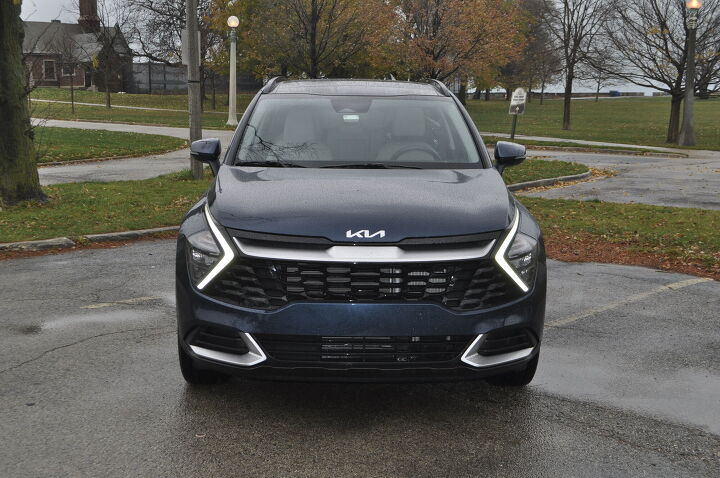2023 Kia Sportage Hybrid EX Review – Urban Crossover, Right Price

2023 Kia Sportage Hybrid EX AWD Fast Facts
You might remember that when yours truly flew to California last year to drive the 2023 Kia Sportage, I didn’t get to spend more than five minutes in the hybrid version. I spent most of my day in the X-Pro, which I was lukewarm about.
A full week with the hybrid showed me I was, indeed, missing out.
The X-Pro Sportage is for “light” off-roading while the hybrid is for urban and suburban commuters, and it’s well-suited to that role. So well-suited, in fact, that I put it on my list of “if I needed a brand-new crossover, I’d consider buying this”.
The hybrid pairs a 1.6-liter turbocharged four-cylinder (177 horsepower, 195 lb-ft of torque) with a permanent synchronous electric motor that makes 59.3 horsepower and 195 lb-ft of torque. There's also a starter/generator motor that makes 17.3 hp and 31.9 lb-ft of torque. The resulting 277 system horsepower and 258 system lb-ft of torque (remember, the numbers from the gas engine and electric motor(s) ARE NOT simply added together for system power, it’s more complicated than that) are plenty to give the Sportage a sprightly feel around town – and you don’t even need to engage Sport mode to get some grins, though it helps immensely.
The juice is supplied by a 1.49 kWh lithium-ion battery. An eight-speed automatic transmission gets the power to the all-wheel drive system.
Acceleration is one thing, ride and handling are another. The Sportage is engaging, despite a bit too much artificialness in its steering feel, and it’s sporty enough to stave off crossover-induced depression. Ride is not sacrificed. If you need a crossover and don’t want to be fighting the boredom that these ‘utes so often bring about, the Sportage Hybrid is worth a look.
Of course, sportiness only gets you so far in crossover land. Even the enthusiast is looking for other positive traits that have little to do with cornering prowess. The Kia delivers here, too, thanks to a comfy cabin that blends functionality and design nicely. Even the sloping rear roofline doesn’t eat too much into rear headroom.
Kia manages to make an all-digital display work – though as is the case with any of these screen-heavy interiors, I wonder about repair costs. It helps that Kia’s infotainment system is simple and intuitive to use.
There is a disturbing lack of knobs and buttons, but the setup works well enough that once you’ve gotten the hang of things – and it doesn’t take long – you can do what you need/want to do while minimizing distraction from the duty of driving. Kia’s neat little swap system – swap between audio and HVAC controls at the touch of a button – helps here, though it does occasionally confound. Do you want the cabin to be cold, or Foreigner’s “Cold as Ice” to play? A certain percentage of the time, you’ll get it wrong, though with time that improves.
At least the heated seats are button controlled. On the disappointing side, my mid-trim EX tester is saddled with dummy buttons for a function that’s not there – I am guessing cooled seats. No one likes being trim-shamed, and it’s obvious that EX buyers couldn’t or wouldn’t pony up more cash for the upper-trim Sportage. Some materials felt a bit cheap, though.
If it looks like I am struggling to pick nits, well, I am. TTAC made its name on calling out the bad, and there’s just not a lot to work with here when it comes to that. The entire package is well put together, balancing fun-to-drive, functionality, and fuel economy. All at a reasonable price.
That’s where I thought this review might turn south – perhaps Kia was shortchanging EX buyers and forcing those who wanted comfort and convenience to shell out too much coin for an SX-Prestige top-trim model. But a quick glance at the spec sheets shows that unless I missed something, the only major features one would want that force you to pony up for an SX-Prestige are cooled seats, real leather seats instead of artificial leather ones, and more advanced driver-aid systems.
This means that for $30K you get standard features like forward-collision assist, lane-departure warning, lane-keep assist, driver-attention warning, dual-zone climate control, Android Auto, Apple CarPlay, heated front seats, and keyless entry. Opting for an EX over the LX adds 18-inch wheels (instead of 17s), LED turn signals, UVO infotainment, blind-spot and rear cross-traffic collision-avoidance assist, navigation, push-button start, satellite radio, heated steering wheel, and rear USB ports.
The only options on my tester were a package that added a sunroof and hands-free liftgate, and carpeted floor mats.
Total price? $33,860 with destination.
Kia’s biggest problem here isn’t anything related to the Sportage per se – it’s that most of the competitive set is strong. Most of the alternatives on offer are also well-rounded, though some are going to cost more when similarly equipped. There are a lot of good choices at this size and price point.
That said, the Sportage Hybrid is fun-to-drive, fuel-efficient (38 mpg combined -- though I was seeing lower numbers. Perhaps we've found another flaw), and put together well. Those who want to go off-road and overland will look elsewhere – and will likely be let down by the X-Pro version – but the city-dwellers and suburbanites will be well served to give this a long look.
What’s New for 2023
The 2023 Kia Sportage is completely redesigned.
Who Should Buy It
Those seeking a well-rounded city crossover at a reasonable price.
[Images © 2023 Tim Healey/TTAC]
Become a TTAC insider. Get the latest news, features, TTAC takes, and everything else that gets to the truth about cars first by subscribing to our newsletter.

Tim Healey grew up around the auto-parts business and has always had a love for cars — his parents joke his first word was “‘Vette”. Despite this, he wanted to pursue a career in sports writing but he ended up falling semi-accidentally into the automotive-journalism industry, first at Consumer Guide Automotive and later at Web2Carz.com. He also worked as an industry analyst at Mintel Group and freelanced for About.com, CarFax, Vehix.com, High Gear Media, Torque News, FutureCar.com, Cars.com, among others, and of course Vertical Scope sites such as AutoGuide.com, Off-Road.com, and HybridCars.com. He’s an urbanite and as such, doesn’t need a daily driver, but if he had one, it would be compact, sporty, and have a manual transmission.
More by Tim Healey
Latest Car Reviews
Read moreLatest Product Reviews
Read moreRecent Comments
- W Conrad I'm not afraid of them, but they aren't needed for everyone or everywhere. Long haul and highway driving sure, but in the city, nope.
- Jalop1991 In a manner similar to PHEV being the correct answer, I declare RPVs to be the correct answer here.We're doing it with certain aircraft; why not with cars on the ground, using hardware and tools like Telsa's "FSD" or GM's "SuperCruise" as the base?Take the local Uber driver out of the car, and put him in a professional centralized environment from where he drives me around. The system and the individual car can have awareness as well as gates, but he's responsible for the driving.Put the tech into my car, and let me buy it as needed. I need someone else to drive me home; hit the button and voila, I've hired a driver for the moment. I don't want to drive 11 hours to my vacation spot; hire the remote pilot for that. When I get there, I have my car and he's still at his normal location, piloting cars for other people.The system would allow for driver rest period, like what's required for truckers, so I might end up with multiple people driving me to the coast. I don't care. And they don't have to be physically with me, therefore they can be way cheaper.Charge taxi-type per-mile rates. For long drives, offer per-trip rates. Offer subscriptions, including miles/hours. Whatever.(And for grins, dress the remote pilots all as Johnnie.)Start this out with big rigs. Take the trucker away from the long haul driving, and let him be there for emergencies and the short haul parts of the trip.And in a manner similar to PHEVs being discredited, I fully expect to be razzed for this brilliant idea (not unlike how Alan Kay wasn't recognized until many many years later for his Dynabook vision).
- B-BodyBuick84 Not afraid of AV's as I highly doubt they will ever be %100 viable for our roads. Stop-and-go downtown city or rush hour highway traffic? I can see that, but otherwise there's simply too many variables. Bad weather conditions, faded road lines or markings, reflective surfaces with glare, etc. There's also the issue of cultural norms. About a decade ago there was actually an online test called 'The Morality Machine' one could do online where you were in control of an AV and choose what action to take when a crash was inevitable. I think something like 2.5 million people across the world participated? For example, do you hit and most likely kill the elderly couple strolling across the crosswalk or crash the vehicle into a cement barrier and almost certainly cause the death of the vehicle occupants? What if it's a parent and child? In N. America 98% of people choose to hit the elderly couple and save themselves while in Asia, the exact opposite happened where 98% choose to hit the parent and child. Why? Cultural differences. Asia puts a lot of emphasis on respecting their elderly while N. America has a culture of 'save/ protect the children'. Are these AV's going to respect that culture? Is a VW Jetta or Buick Envision AV going to have different programming depending on whether it's sold in Canada or Taiwan? how's that going to effect legislation and legal battles when a crash inevitibly does happen? These are the true barriers to mass AV adoption, and in the 10 years since that test came out, there has been zero answers or progress on this matter. So no, I'm not afraid of AV's simply because with the exception of a few specific situations, most avenues are going to prove to be a dead-end for automakers.
- Mike Bradley Autonomous cars were developed in Silicon Valley. For new products there, the standard business plan is to put a barely-functioning product on the market right away and wait for the early-adopter customers to find the flaws. That's exactly what's happened. Detroit's plan is pretty much the opposite, but Detroit isn't developing this product. That's why dealers, for instance, haven't been trained in the cars.
- Dartman https://apnews.com/article/artificial-intelligence-fighter-jets-air-force-6a1100c96a73ca9b7f41cbd6a2753fdaAutonomous/Ai is here now. The question is implementation and acceptance.







































Comments
Join the conversation
What is a "city crossover"?
I have not been shopping the H/K gas models because of what I read was a problem with their motors failing too quickly. I think partially due to engine block reaming shavings not being completely removed by an american castings manufacturer. Is the "all clear" being sounded? Their gas motor problems are behind them?